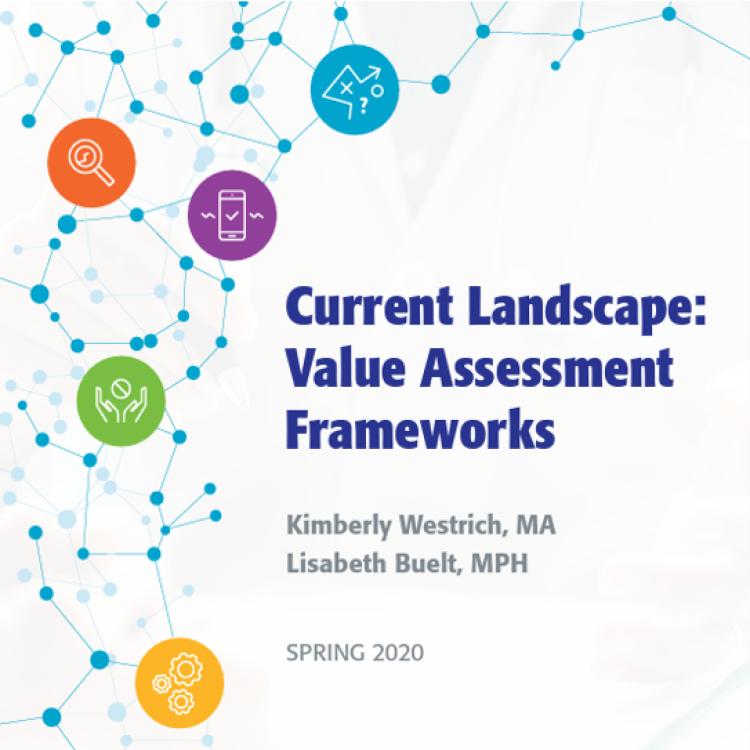Most of the value assessment frameworks in development today have created new (and untested) methodologies for assessing value or are using an untested combination of new and tested methodologies.
The table below compares the methodologies of seven frameworks in use in the United States: the American College of Cardiology and the American Heart Association Statement on Cost/Value Methodology in Clinical Practice Guidelines and Performance Measures, the American Society of Clinical Oncology’s Conceptual Framework to Assess the Value of Cancer Treatment Options, Memorial Sloan Kettering Cancer Center’s DrugAbacus, the Institute for Clinical and Economic Review’s Value Framework, the Innovative and Value Initiative Open-Source Value Project, National Comprehensive Cancer Network Evidence Blocks, and the Patient-Perspective Value Framework by Avalere and FasterCures.

It’s important to recognize the methods that frameworks use so the outputs can be reviewed in their proper contexts. The target audience of each value assessment framework varies, so the assumptions and analyses used by a given framework might not be relevant for every stakeholder or health care decision. Now that frameworks are being used to inform health care decision-making, it is critical that the underlying methodologies are sound and validated, and their potential impact on patients is understood.
Are there general principles to which value assessment methods should adhere?
NPC has developed guiding practices for value assessment. For methodologies, NPC makes the following recommendations:
- Value assessments should focus broadly on all aspects of the healthcare system, not just on medications. Focusing on one component of an interconnected system does not provide a complete perspective on the system. Medications are one component of the healthcare system. Focusing only on medications, and excluding the rest of the healthcare system (e.g., procedures, diagnostic tests, hospitalizations, office visits), will result in an incomplete assessment.
- Methods should be based on established health economic methodologies, consistent with accepted standards. Health economic assessment is a very complex and sophisticated undertaking and many bodies of work and years of debate have shaped the methods. Following accepted methodological standards (e.g., ISPOR Good Practices, Cochrane) is necessary to produce a meaningful and credible assessment of value.
- Methods, models, and assumptions should be transparent and assessment results should be reproducible. To build credibility and trust in an assessment, the methods, models (including all calculations), and assumptions included in the assessment should be transparent to interested stakeholders, and they should be able to reproduce the assessment results on their own.
- Base case assumptions must represent reality. As the base case is the underpinning for all assessment results, it is critical that the assumptions inherent in the base case are realistic and accurate. Value assessment includes many assumptions, and these assumptions will drive the final results; unrealistic assumptions will drive unrealistic results.
- Sensitivity analyses should be performed, taking into account input from external stakeholders. Where sensitivity analyses result in material changes to the interpretation of the results, a focused discussion should be included. Performing sensitivity analyses around key assumptions will identify how results could vary in differing scenarios, and will generate a range of potential results. The implications for the user may vary across this range, so clear guidance will be needed to help them understand which assumptions are driving the differences and why.
- Weights should be included to accommodate varying user preferences. The user should be able to adjust the assessment assumptions and parameters to accommodate individual preferences for different outcomes and factors (e.g., patient preferences for clinical benefit vs. side effects) and make adjustments to represent different scenarios (e.g., payer ability to vary the population).

NPC analyzed seven existing U.S. value assessment frameworks, comparing and contrasting the strengths and limitations associated with each framework.
Emerging methodology: Multi-criteria Decision Analysis (MCDA)
Multi-Criteria Decision Analysis (MCDA) is an emerging approach to value assessment that takes patients’ concerns, experiences and treatment preferences into consideration. It offers a unique way to quantify what matters most to patients when they consider the value of a health care treatment and its impact on their quality of life.
How Is MCDA Conducted?
MCDA uses either qualitative or quantitative transparent, structured processes. As a first step, a wide variety of data points are gathered, including clinical evidence and outcomes and treatment characteristics that are important to patients and caregivers, based on individual inputs. This could be done via surveys, questionnaires within patient registries or other data collection tools, as long as the process is transparent and clear to participants. Different MCDA processes incorporating this data are then chosen for use, depending on the type of decision being made and the individuals making the decision. These processes could include an in-person group discussion or surveys; the main purpose is to deliberately consider all of the criteria going into a decision, and carefully weighing all factors based on their importance to the participants.
MCDA, like other value assessment methods in the United States, is still in its infancy. Encouraging broader use of MCDA will require further collaboration with patient organizations, researchers and other health care decision-makers to pilot test MCDA and expand the types of value assessment methods they use. In addition, stakeholders will need to be trained on how to conduct and translate MCDA into usable information.

Learn more about multi-criteria decision analysis and how this method can be used in value assessment.
